Eipo Numerals
Peter Damerow had a deep interest in the ways members of traditional societies count, think, and see the world. He knew about our interdisciplinary research project in the isolated mountains of West New Guinea and invited me to workshop meetings on counting systems and early arithmetic. Our ways of approaching scientific questions and our personalities “clicked.” We became friends and Peter was soon a guest in my little mountain house in Tyrol where we talked, our backs against the tile stove, a glass of wine in front of us, about numbers, but actually more about the world.
The Eipo (Schiefenhövel 1976, 1991, 2014a), like other Highland Papuan groups east and west of the international border between the Indonesian Province of Papua and the independent State of Papua New Guinea, have a specific system of counting and of numerals (Heeschen and Schiefenhövel 1983, 18). There are four (+ two) actual numeric terms: “ton” (1), “bedinye” (2), and “winilye” (3), represented by the small, the ring, and the middle finger of the left hand, “winilyaba” (23, middle finger of the right hand), “bedinyaba” (24, ring finger of the right hand) are variations of the terms for 2 and 3; “seselekyaba” (25) the small finger of the right hand is the fourth genuine numeral. Interestingly, these last three numerals have a different suffix (“-yaba”) than the others (“-digin”) represented on the left side of the body.
Returning to the ordinary way of counting: “dumbarye” (4) is located at the index finger of the left hand, “fangobarye” (5) at the thumb, “nakobarye” (6) the pulse, “tekbarye” (7) the middle of the lower arm, “finbarye” (8) the elbow joint, “toubnebarye” (9) the middle of the upper arm, the biceps, “takobarye” (10) the shoulder, “koklombarye” (11) the neck, “obarye” (12) the left ear, “mekbarye” (13) the crown of the head and the middle of the string of body-defined numerals, “odigin” (14) the right ear (all body points now appear in reverse order on the right side of the body), “koklomdigin” (15) the neck, “takubdigin” (16) the shoulder, “toubnedigin” (17) the middle of the upper arm, the biceps, “findigin” (18), the elbow joint, “tekdigin” (19) the middle of the lower arm, “nakubdigin” (20) the puls, “famdigin” (21) the thumb, “dumdigin” (22) the index finger, “winilyaba” (23) the middle finger, “bedinyaba” (24) the ring finger, and “seselekyaba” (25) the small finger.
“Ton,” “bedinye,” and “winilye” thus are real numerals for 1, 2, and 3 (they don’t mean anything else), counted on the left hand. As described above, “winilyaba” and “bedinyaba” signify, in a kind of mirror reflection, 23 and 24, but really keep their semantics as numerals attached to the two specific fingers. “Seselekyaba” (25) represents the end of the counting row and is another real numeric term; all the others are linguistically built on the terms of the particular body part: “dume” is the index finger, “fame/fango” the thumb, “nakob/nakub” the region of the puls (cp. “nakubnakub an” – to pulsate), etc. That counting begins on the left side of the body is easy to understand; it represents, for the majority of right handers (McGrew, Marchant, and Schiefenhövel 2013), a sensomotorically intuitive way, namely pointing with the thumb of the right hand to the left hand and the other points on the left side.
When our group arrived in the southern Eipomek Valley in July 1974, everybody, including children, could count in this traditional way. The expression “yupe bedinye” (language/counting two, i.e., twice counted) was an approximate term for 50. In real life, however, the ability to count by using a row of numerical/body point terms was not used very often, considerably less than in our types of cultures which are very number oriented. The size of groups of people or the number of objects would rather be expressed as “meteik” (small) or “weik” (big). Only when it really mattered, like in the transaction of exchanging stone adze blades for some other valuable goods, the actual number, the sum, would be established by counting every item. Or if one talked about the number of people killed in the war between the Eipo and their hereditary enemies in the adjacent Famek Valley, then the name of the victims would be named and given a numerical point on the body. I have not seen or heard anyone, in the days before school education, doing arithmetic calculations beyond the addition of the first few numerals, that is, small numbers, even though such simple arithmetic would have been quite easy with that elegant intuitive system starting with the five fingers of the left hand and finally arriving at 25. Never have I witnessed anybody performing a subtraction based on the counting system, nor, understandably, multiplying or dividing. It was just not part of their tradition and not necessary for daily life.
I find it interesting that children in our countries learn relatively easily to say the more or less correct row of numbers (obviously a linguistic performance just like saying another string of words), but only much later learn to associate the specific numeral with a specific object, that is, really count, and, again much later, do correct simple arithmetic—in the beginning probably always connected to fingers, apples, and the like. It must be rather difficult for the brain to perform these tasks and calculations and it does not surprise me, therefore, that this cultural technique developed so late in history. It is not that the Eipo brains can’t do it, far from it! They very quickly learned the basics of our Western way of arithmetic and almost everyone, including the older people of both sexes, can handle the large numbers involved in paying with Indonesian money where one euro is about 13,000 rupiah and one soon gets into astronomical numbers even calculating the price of a pig or buying a flight ticket from Eipomek to Sentani, the airport near the provincial capital of Jayapura. The human brain, it seems, does not necessarily lend itself to arithmetic if there is no good reason to do so. Peter Damerow in his scholarly work (vis-à-vis my sketchy observations) has stated that counting and counting systems occur quite late in history (2012). Human life is quite possible without them.
Early Contacts
As mentioned above it is very interesting to notice that the Eipo, in the very rapid transition from a classic non-literate Papuan society with a stone age tool kit to modernity, so quickly learned to handle numbers (the ones of Bahasa Indonesia as well as their own, which now became real arithmetic tools) and to manage the different challenges connected to paying and receiving cash money, to calculate costs, gains, and losses in case they have one of the little stores in the villages where some basic goods are sold. Every single item must be bought in the provincial capital Jayapura and its suburbs and brought by plane to Eipomek; the freight, like passenger tickets, must be paid in cash. Not only a challenge for arithmetic performance but also a complicated logistic problem (transporting the goods, storing them near the airport, getting one of the scarce flights, etc.), which many of the Eipo master extremely well.
It was not, I would argue, the very basic, often inadequate system of school education which effectuated the ability to cope with the modern world. It was much more the trickling process of innovation, which entered, in many shades and forms, life in the hitherto very isolated mountains. The gifted ones quickly and often informally learned the new techniques to count, read, write, and handle money first; from them the others learned. Just like in the case of learning Bahasa Indonesian, which spread surprisingly quickly. Many of the Eipo by far surpass my knowledge in this language.
It must have been similar in the Roman Empire, when the soldiers introduced Vulgar Latin as a lingua franca. It spread with considerable speed and so efficiently that in large parts of the conquered and administered territory (e.g., Italy, France, Spain, Portugal, Romania) hardly any of the former languages survived. Yet this process took from about 200 BCE to 100 CE (cp. Cerquiglini 1993, Roegiest 2006). The spread of such cultural techniques as building roads, growing wine, and a money-based market system happened alongside and beyond the 300 years of linguistic acculturation. People are, generally, attracted by advantageous new ways of lives, whereas their cultural institutions guard tradition. But despite its revolutionary nature and the push of the unifying Roman administrational system, linguistic acculturation in the occupied European territories took approximately 12 generations.
The Papuans, autochthonous people of New Guinea whose ancestors arrived about 50.000 years b.p. (cp. Schiefenhövel 2014a), have undergone a much more dramatic change. When the first group of our interdisciplinary project “Man, Culture and Environment in the Central Highlands of Irian Jaya, West-New Guinea,” initiated by Gerd Koch (1977) of the Berlin Museum for Ethnology and funded by the Deutsche Forschungsgemeinschaft, arrived in the southern Eipomek Valley after five days of walking from Bime, the then closest airstrip, the Eipo and their neighbors had a neolithic tool kit and lived, with regard to subsistence socio-political structure, the stone age lives of their ancestors.
In 1959–60 the team around the French journalist and adventurer Pierre Gaisseau had walked, during an incredibly demanding expedition, the breadth of then still Nederlands Nieuw Guinea from the south coast to the Mamberamo River in the northern lowlands; two members even continued to the provincial capital Hollandia. After crossing the central cordillera, the team descended with great difficulty into the Eipomek Valley and thus were the first foreigners whom the Eipo ever saw. The film Le ciel et la boue (The sky above, the mud below) documents this quite friendly and animated encounter. From October to December 1969 Gaisseau came back, this time accompanied by a group of Indonesian military. They parachuted into what was then called X-Valley (according to the confluence of three rivers), built a camp, and stayed for several weeks with the Eipo. The team members collected (at that time unknown to fieldworkers) a first list of their language, recorded the size of settlements, production of food in the gardens, and the health condition of these pristine people (Komando Daerah Militer XVII “Cenderawasih” n.d., Hariono 2003). The team had to be rescued by helicopter after their attempt to float down one of the rapid rivers further east ended in disaster, with several members injured and all the newly made film footage of Gaisseau lost. After this, a few missionaries of the Unevangelized Fields Mission, UFM, crossed the region but did not build a mission station or airstrip in this region.
Our group consisted of the ethnologists Gerd Koch and Klaus Helfrich, the linguist Volker Heeschen, the dental anthropologist Grete Schiefenhövel, and myself, a medical doctor who had worked on anthropological and ethnomedical topics in New Guinea since 1965. When we arrived, the Eipo were still leading a neolithic life as horticulturists, gatherers (mainly a female activity), and hunters with their religion and other traditions intact. As the Eipo and their farther neighbors, of whose existence they hardly knew, had no name comprising all groups with the same language and culture, I suggested the term Mek, the term for “water” and “river.” The people formerly called Goliath Pygmies (after the Dutch name Goliath given to one of the mountains south of the central chain, rather a misnomer because the Mek are of very small stature), Kimyal or Ketengban are now known under the name Mek in linguistics and anthropology. A dictionary of the complex Eipo language (Heeschen and Schiefenhövel 1983), a substantial number of monographs as well as ethnographic and human ethological films have been published documenting everyday behavior as well as ceremonies and rituals (cp. Human Ethology Film Archive, now at Senckenberg Research Institute and Museum, Frankfurt). The Eipo lived, between 1974 and 1980, the life which had been typical for other traditional Papuan groups of the very isolated mountainous inland of the big island New Guinea east and west of the international border—only that practically all other groups had been subject to cultural change brought about by Christian missionaries, some form of government administration, and/or, in some cases, by large-scale oil/gas and gold/copper exploitation.
The Eipo had a remarkable knowledge of flora and fauna and their taxonomic system reflected morphological similarity as well as genealogy almost in the same way as the Linnean system (Hiepko and Schiefenhövel 1987). Eipo informants were always right when they claimed, often to the disbelief of the two botany professors of the research team, that two plants were “brothers”: they indeed belonged, in every single case, to the same genus or at least family. Their anatomical knowledge was astounding, too. The function of the kidneys, the ureter, the bladder, and the urethra was well known as well as the fact that when a female pig was slaughtered at the moment of being in heat one could see little yellow spots (the Graf follicles) on the ovaries. Yet they did not associate this with possible pregnancy, as they believed that an embryo was formed by the held back menstrual blood and the sperm. Their stories, legends, and myths (Heeschen 1990) as well as the lyrics of their love and mourning songs (Schiefenhövel 2014b) bear extraordinary testimony to their creative power and the quest for verbal beauty.
After the German Research Team had ended its main projects, which coincided with the destruction, by two powerful earthquakes in 1976, of the landing field for small aircraft, and the start of mission work by representatives of the UFM, the Eipo turned away from their traditional beliefs and became Christians. This process happened around 1978–1980. They were not primarily attracted by the revolutionary theology of the New Testament. Their reason to fundamentally change their way of life was rather triggered by their insight that they had lived the basically stationary, unchanged existence of an almost completely isolated, marginalized group of stone age people in a world of high tech products, formalized education, high speed communication and transport, market economy, and globalization. In the past they had but glimpses of the outside. As all the neighboring valleys, except one, had also remained in the prehistoric mode of life, they did, for some time, not feel motivated to leave the known ground of their traditions and depart to unknown shores. To become Christians was a political rather than a religious decision. And it therefore happened in a very unified way: basically everyone in the communities of the Southern Eipomek Valley went along with the change. All received new names, many attended the Sunday service in the newly built church, listened to the stories of the Bible, and learned new songs and rituals. Some children began to go to the small elementary school erected in Eipomek. This was the beginning of a most dramatic and radical change involving all members of the society.
The Eipo, led by very intelligent men, mostly actually those who had been our informants teaching us their language and their traditional view of the world, have so far resisted the ever-present lure of cargo cult ideas (Lawrence 1964). They understand that money and other wealth won’t come through some religiously fabricated miracle but only through education and hard work. When in the neighboring Famek Valley, the place of their former enemies, a “prophet” promised to cause, through the performance of a syncretistic religious ceremony, a rock to explode and spit out unimaginable amounts of Indonesian Rupiah, Philippus-Walabyan, one of the leading men from Eipomek, was able to convince them that this “technique” would not work. The Famek people then discontinued their incipient cargo cult.
Coping with the New World
In summer 2014 approximately 30 Eipo students were enrolled, in different faculties, most commonly the one for Teacher Training, at Cenderawasih (Bird of Paradise) University in Jayapura, the provincial capital. Some were studying law and other subjects at the private Muslim University in the same town and a few had been accepted at prestigious universities in the State’s capital Jakarta, in Bandung, and in other cities. One young Eipo, at that time studying Administrational Science in Jakarta, had been selected to be sent to a university in the United States, but due to the sickness of a family member he stayed in Indonesia. Of those who have finished their university education, some are employed by the government and serve as administrators in their own Star-Mountains Regency, some are administrational heads or nurses of local health stations (Pusat Kesehatan Masyerakat) in the Eipomek valley or in different areas of the province, and some are primary school teachers, one of them in the six-class elementary school (sekolah dasar) in Eipomek. Probably more than 100 Eipo live at the coast, usually in Sentani where the airport is located, which serves domestic and international destinations. One Eipo was elected member of the local parliament; he is also the first who had a modern house built for him and his extended family in one of the suburbs of Sentani.
Almost all of those who stay permanently or periodically in this buzzing, crowded Indonesian City of more than 250.000 inhabitants cope with the challenges of everyday life—accommodation, transport, communication, finding income or family members who support them—with seeming ease. Almost everybody has a mobile phone, usually the smart phone version, and many are well trained to work with computers.
One young Eipo has created a website called “likteam” (“lik” is a proverbial Eipo expression meaning “I am not inclined, I don’t want” and a term for the dialect in the Eipomek Valley, as it is not found in the other versions of the Mek language). He and some others have worked together with Andrew Sims, an American mission linguist, to translate the bible into the Eipo language, a work that is now finished. Many villagers use their stay at the coast to buy large quantities of basic foods (rice, noodles, cooking oil, tea, coffee, sugar, etc.), but also sophisticated items like deep-frozen chicken from Java and eggs from Sulawesi. Profit is good despite the fact that every single carton or bag must be flown in by single-engine aircraft to Eipomek. The Eipo have built, within 40 years, three airstrips: the first one with me as “engineer” in 1974–75; after its destruction by the earthquakes in 1976 the UFM mission helped them build a second one; and in recent years they have decided, on their own, to construct, with shovels and other simple tools, a third landing field at yet another spot which would allow larger airplanes to land and take off. They have succeeded. The first airstrip was 366 m long with a slope of about 5%, the latest one is about 550 m long and has a similar slope. When I asked them why they were taking on this enormous task, they said: “We need a big lapangan terbang so that big planes come and we are the center of our region.” In other words: “We don’t want to be Düsseldorf, but Frankfurt.”
Their ambitions are unbounded and it is great to see how they try to manage with the massive cultural changes bringing not only progress but also many new problems, like dramatic population growth. Some of their answers have been ingenious. From David Cole, the first missionary who stayed with them, they learned to grow Chinese carp and other fish in ponds. He also gave them some brood to try on their own. It is now a new sign of high rank to have a number of well-built, well-functioning fishponds; some men have five or more. The number of fish is quite astounding, and some are 2 kgs or more. This is an extremely important and at the same time completely new source of protein for their growing families. Until 1980 the Eipo had never even seen fish at all; the rivers in the mountains are too swift for any fish species to make their way up to the high valleys. When one sees them now handling their fish breeding enterprises one is amazed: it is as if they had always done this.
The same is true for riding motorbikes or cars in and around Jayapura and for repairing them. Many of the young men who dare to immerse themselves in the battle of very dense and—for Europeans—crazily chaotic traffic on narrow roads don’t have, as they told me, a driving license! They would need that only if they were to register a motorbike or car in their own name. It seems that police are lenient with them. I wonder whether that is also true if they are the riders of motorbike taxis (ocek in Bahasa Indonesia), a job that some Eipo do, that is, they take passengers, usually women with large bags of goods from the supermarket, and drive them, for small amounts of money, right to their doorstep.
In February 2010, four of our local co-workers visited Europe for one month. It was not the best time of the year (with snow in Bavaria and Tyrol) but they managed the cold just as all other challenges with remarkable calm, realism, and intrepidness. When we were inside Munich’s Frauenkirche, they looked up to the ceiling far above them and asked: “Who made this, people?” and were impressed to learn that this was done 500 years ago without modern technical machinery. They were very interested to see, in the Deutsches Museum, the history of airplanes, from the first gliding devices to their present form, the technique to mine iron ore and salt with simple tools, and other primordial ways to master nature. Being below the surface of the earth, for instance in the Munich subway, caused some slight uneasiness. Other than that they felt great, especially when they got the famous, big roasted pork knuckles at Kloster Andechs. When we were looking at a large display of stone adzes in Munich’s prehistory museum, one of them asked me: “Did you bring our adzes here or are these the ones of your ancestors?” That was exactly what we had hoped for: that they would understand our high-tech lives had humble origins, origins which survived in their homeland until the twenty-first century.
The New Cultural Center in Eipomek: Keeping History Alive
Knowing that there were some houses with well-functioning solar electricity by then, in 2008 I brought my laptop for the first time and started to show some of the films from the mid-1970s documenting aspects of Eipo traditional life. Soon we had to move to a school building because everyone wanted to see the images of the past, scenes the young ones had no idea of. It was, judging by the noise and the excitement, like a revolution. Obviously this was extremely important for them. A few of the leaders came to talk to me about their request. “You know, we have no history,” was their astounding statement. They used the loan word from Bahasa Indonesia sejarah for history: “We have no drawings, no pictures, and no writings from our old times. You have documented our customs, our culture by photograph, film, and tape recorder. Can you give this history of ours back to us, so that our young people don’t lose contact to their roots?” I was stunned. What a wise assessment and what a beautiful request. We made plans and I suggested the name “Pusat Budaya” (Cultural Center), but in time it became obvious that they wanted the English term “Center” to be part of the name because this had a special, international linguistic appeal… in Indonesia as well as in other countries, Anglicisms are en vogue.
The German Foreign Office in Berlin provided funds for the “Center Budaya Eipomek” and after some years of negotiation and finding official partners in Papua, the building and a large, nicely constructed guest house were officially opened on July 4th, exactly 40 years after the first group of German fieldworkers had arrived in the southern Eipomek Valley. The round cultural center, shaped as the traditional men’s houses, and the guesthouse are thatched with tiles of red aluminium resembling Dutch roof architecture. The walls are decorated with ethnographic items donated by the Eipo themselves and by large-scale photographs from the 1970s, depicting events and ceremonies, which the young ones have never seen. The local government of the Starmountains Regency has put up a large amount of money (at least twice the German contribution) to finalize the project.
The center is now equipped with electric wiring (power comes from a hydroelectric plant not far away) and with a good laptop, a projector, and a large screen so that the Eipo can view the documents we made. Favorites are the films of large feasts and ceremonies as well as footage showing children’s play; the former actors are now women and men in their fifties and very much enjoy watching the lively interactions they had with their peers. The Eipo know that in centralized Indonesia such a cultural center in a small remote village is something unusual. They also know that their culture and their environment are among the best researched in New Guinea and Melanesia. All monographs published in the Series “Mensch, Kultur und Umwelt im zentralen Bergland von West-Neuguinea” plus a number of other publications and many photographs are stored in a glass cupboard. The Eipo hope that this special feature of their valley will also help to attract tourists who are interested in their former and modern way of life and the beautiful alpine landscape they live in.
The Human Brain: A Flexible Organ
Summing up, it is, I believe, no exaggeration to say that the Eipo and their neighbors in the adjacent valleys have made the critical transition from the stone age to our global times surprisingly well. Many would probably hold the view that one cannot jump from prehistory to the modern world in just 40 years, that it is necessary to culturally acclimatize over a longer period of time. That one would need to know about Aristotle, the Renaissance, and at least some parts of the world’s literature. This viewpoint is often taken to explain why, in developing nations, the process of sociocultural and economic development is often so painstakingly slow and sometimes does not seem to work at all. Albert Maori Kiki, one of the first generation of modern politicians, co-founder of the unions in Papua New Guinea, and a strong advocate for its independence, called his most interesting autobiography Ten Thousand Years in a Lifetime (1968). This is a very apt description of what has been characteristic in many parts of New Guinea. The case of the Eipo is even more dramatic than the case of Kiki’s upbringing, because life in Jayapura, modern means of communication, and modern media today are even further removed from Papuan traditions than the world in which Albert Maori Kiki grew up in the 1960s.
The human brain, as evolutionary epistemologists Konrad Lorenz (1973) and Gerhard Vollmer (1975) demonstrate, is primarily an organ to ensure survival, not necessarily to find truths about the world. I hope it has become apparent from this description of the Eipo’s passage from stone adze to smart phone in just one and a half generations that our brain is extremely flexible. It can handle drastic changes of environment, be they natural or cultural. That is, I think, a good message.

Fig. 18.1: Prehistory lasting into the present: A man from Larye, a Mek language area, knapping, with amazing professionalism, a block of Andesit rock into a stone adze blade. Even today (2018) this technique is in practice because stone adzes are often part of bride price and other ritual payments.
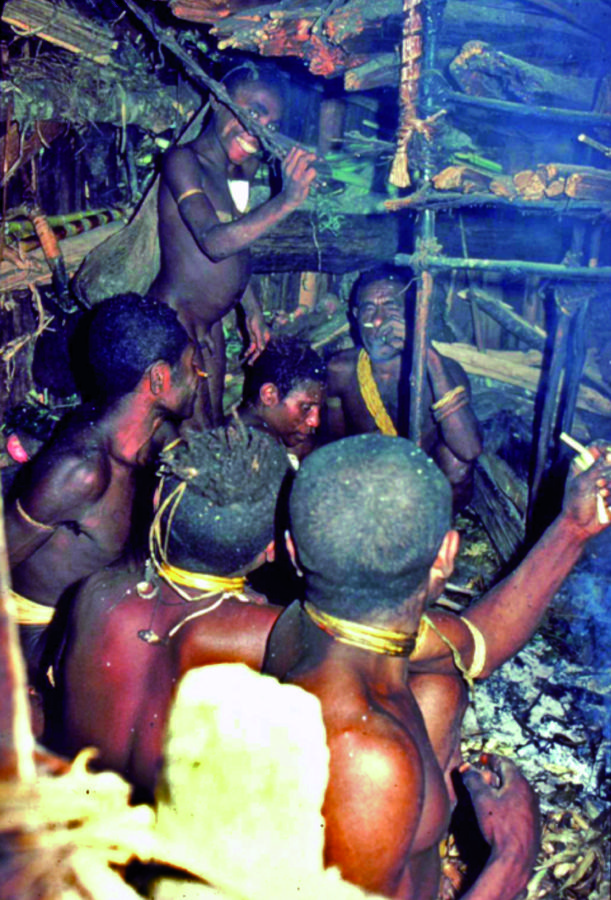
Fig. 18.2: Coming together after a day’s work in the gardens and the rain forest. The family huts of the Eipo were very small, preserving the warmth of the fire place in the cold nights. A hafted stone adze is placed at the left wall.

Fig. 18.3: An Eipo family in their modern house, provided by the government. The battery on the left is connected to a solar power system providing electricity for lighting and CD players. As these houses have no fire place (the design is borrowed from Sulawesi), the Eipo cook and eat dinner in traditional huts, where they also sleep in the night, cuddled around glowing embers.
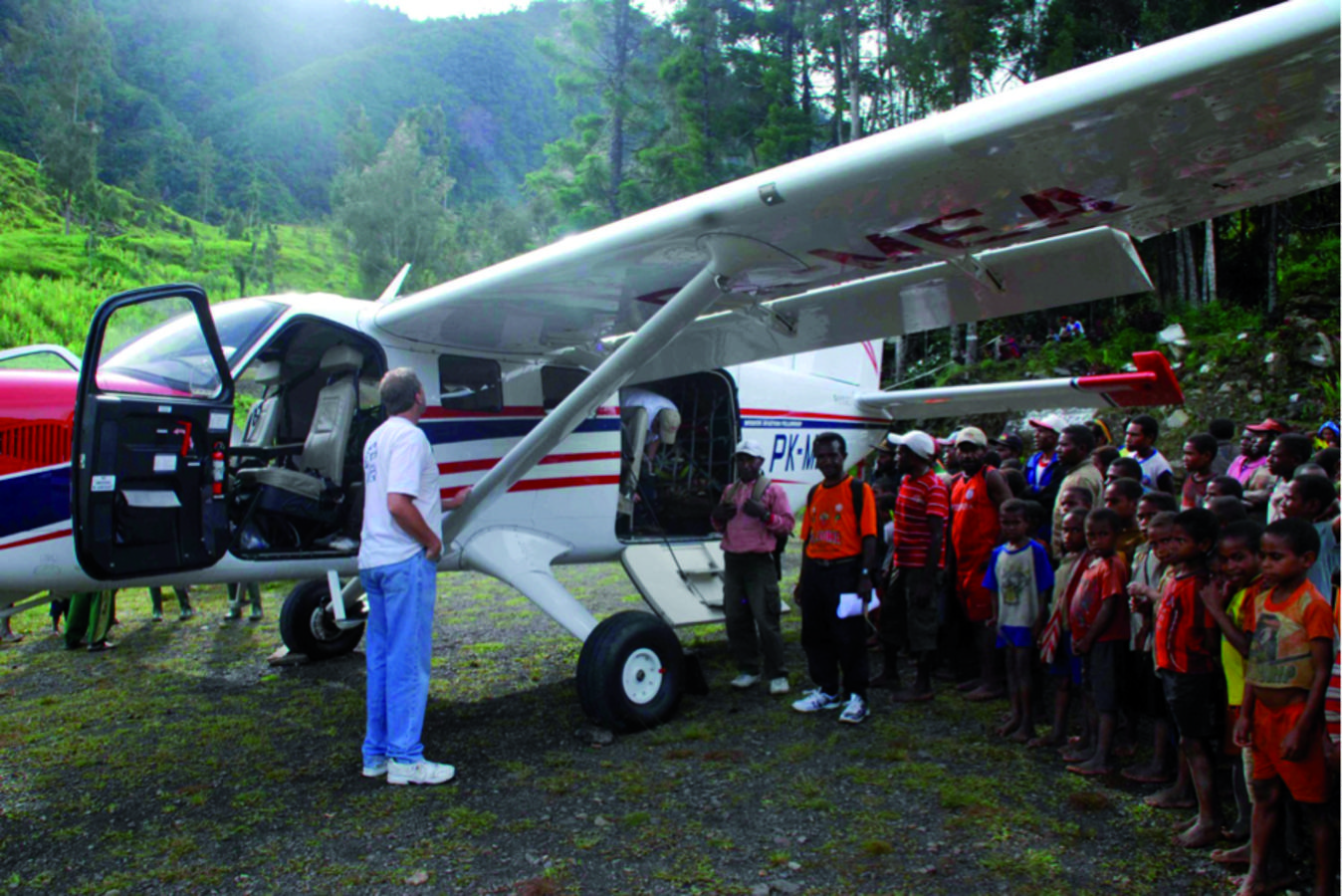
Fig. 18.4: Single engine airplanes are the only means of transport to the urban centers at the coast, 200 km direct line away. This is the third airstrip the Eipo have built in 40 years. It is 550 m long at a 5% slope and enables larger aircraft than the usual Cessna and Pilatus Porter to land: competition with other valleys.
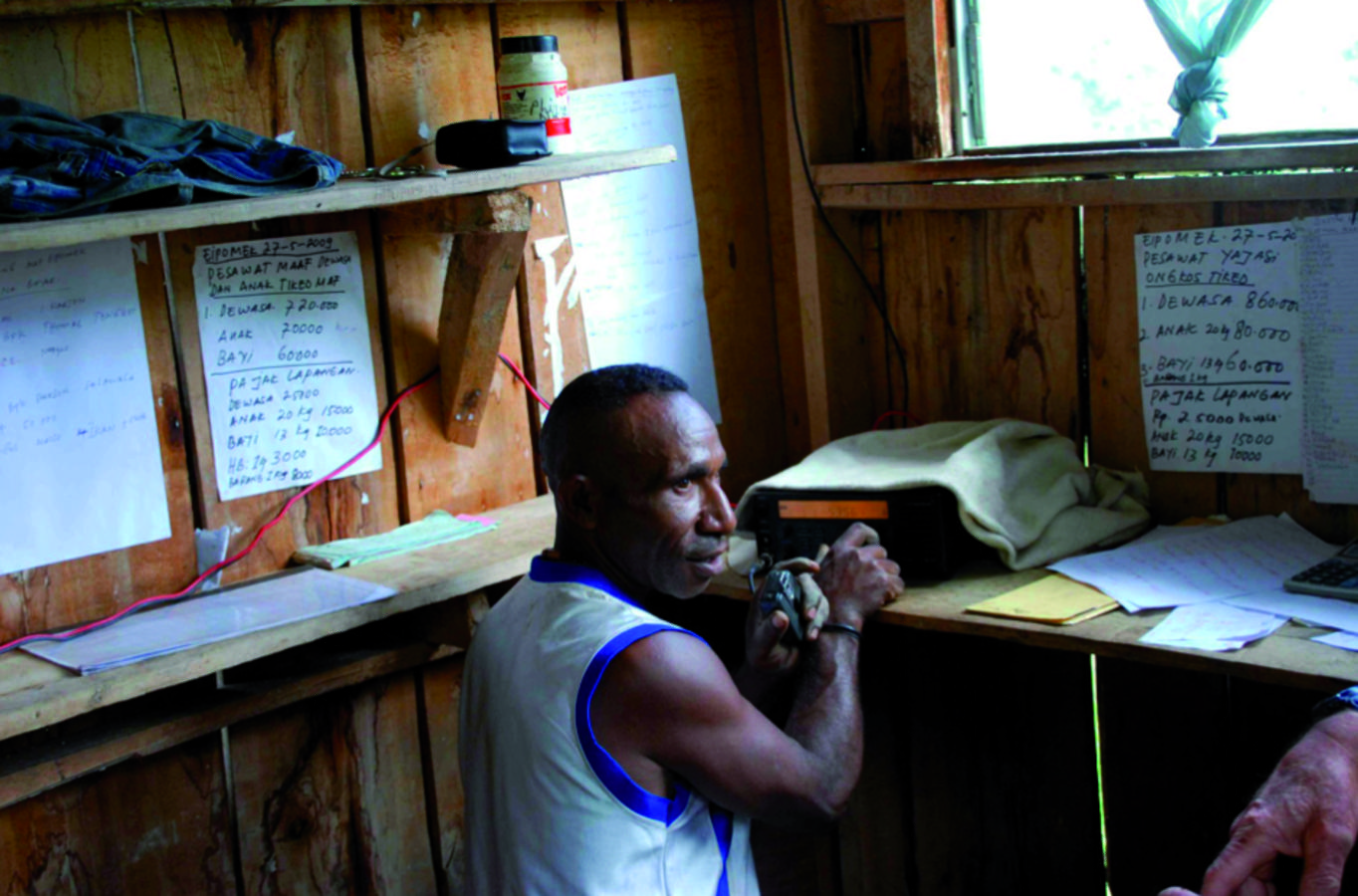
Fig. 18.5: Silas-Nyenye, son of a “Big Man,” is doing “the sched”: communicating, in Bahasa Indonesia, with the airlines, the pilots, and other stations via single-side-band radio. No phones work yet in the isolated mountains. The Eipo are amazingly skilful and reliable in this demanding task.
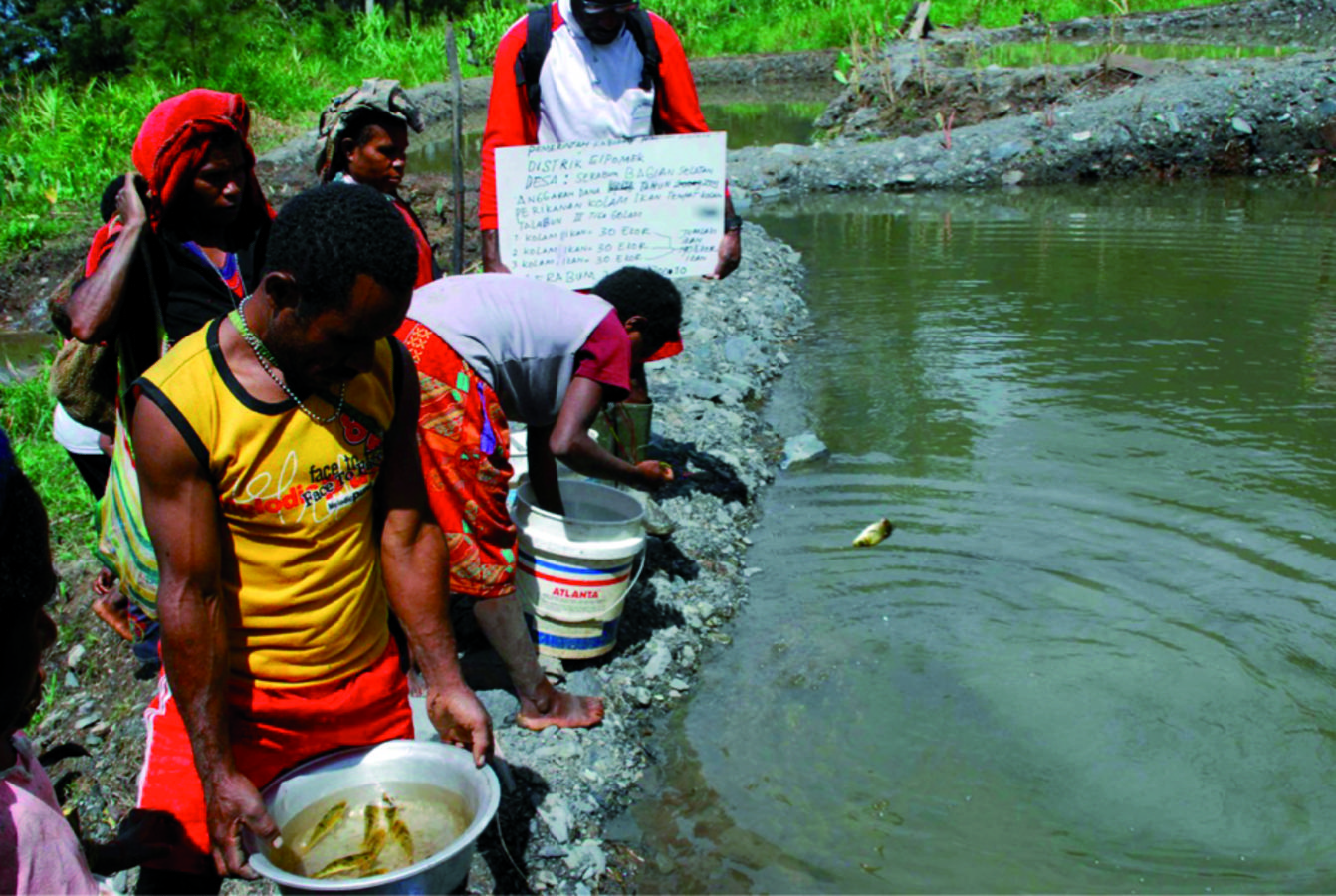
Fig. 18.6: Breeding fish in specially constructed ponds has become a sign of high status; formerly, no fish lived in the fast flowing rivers of the central highlands. For the quickly growing population, carp and tilapia provide valuable protein. The owners get cash income from this new economic activity and sometimes export fish (in buckets transported by airplane) to other areas.
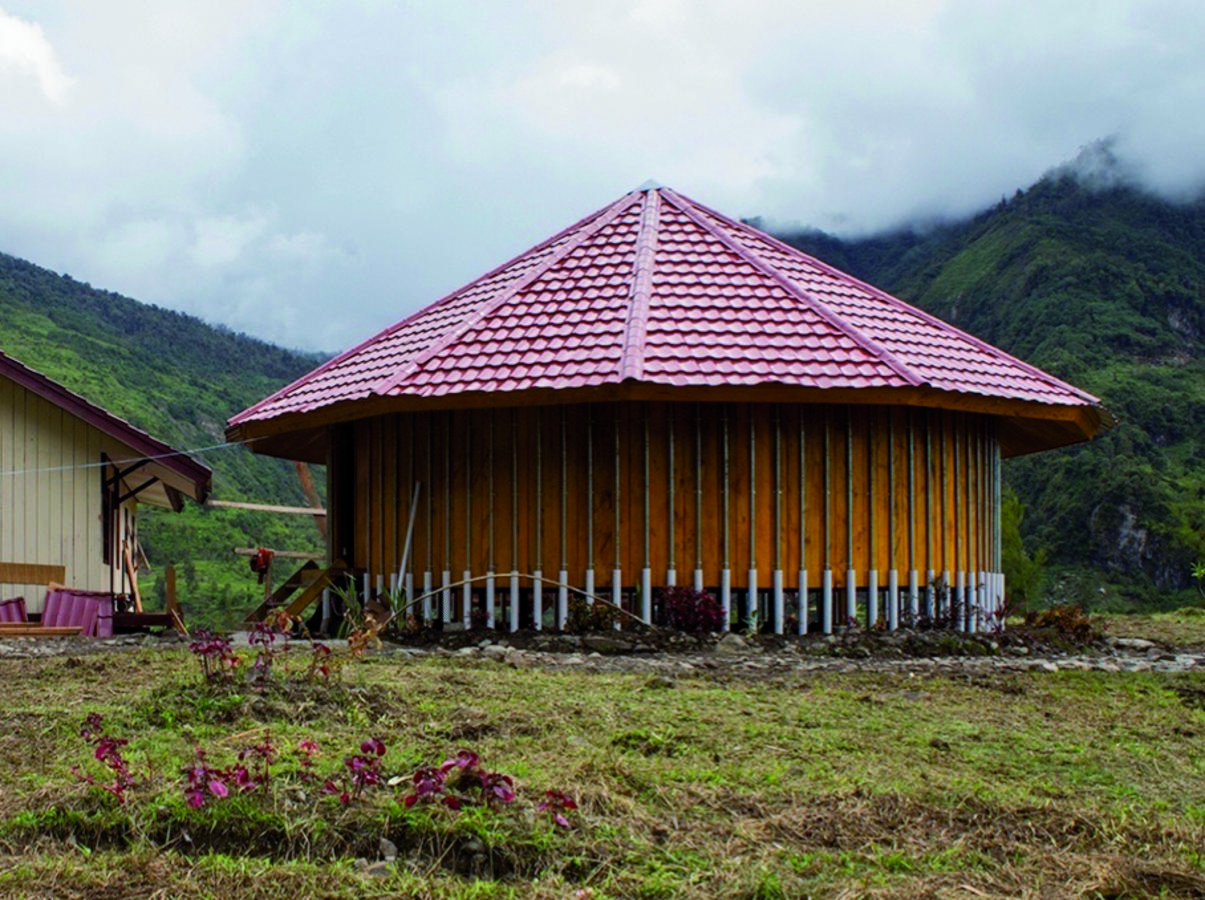
Fig. 18.7: “Center Budaya,” the Cultural Center Eipomek, built with German and Indonesian funds. It houses a large collection of photographs, films, and publications documenting traditional life and customs before the Eipo decided to become Christians around 1980 and serves as a way to “preserve our roots,” as the Eipo say. They are proud of this institution in their valley; other museums devoted to the history and culture of Papuan peoples are restricted to the urban regions.
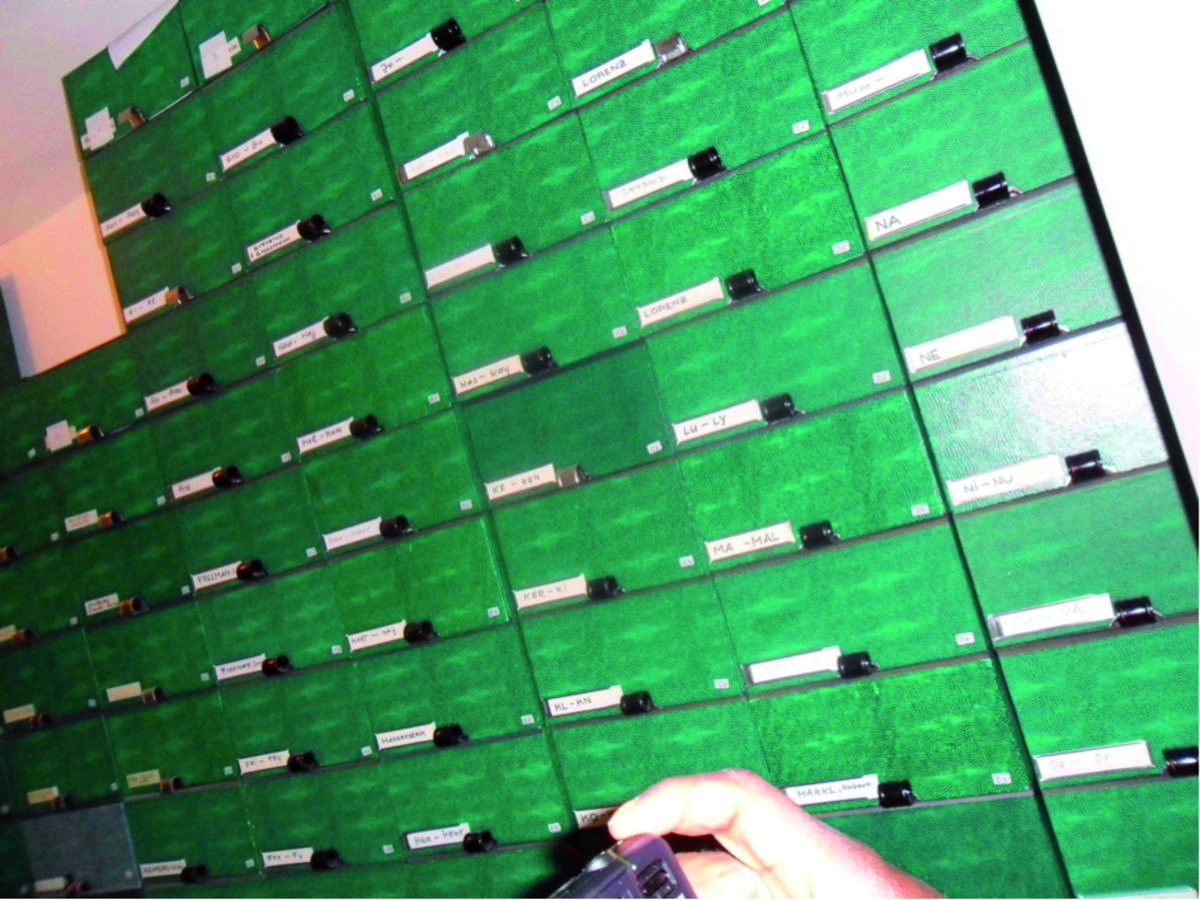
Fig. 18.8: Four Eipo friends visited Europe in 2010. Upon their arrival, they got photo cameras and immediately started to document our world. They were fascinated by the filing system for reprints...
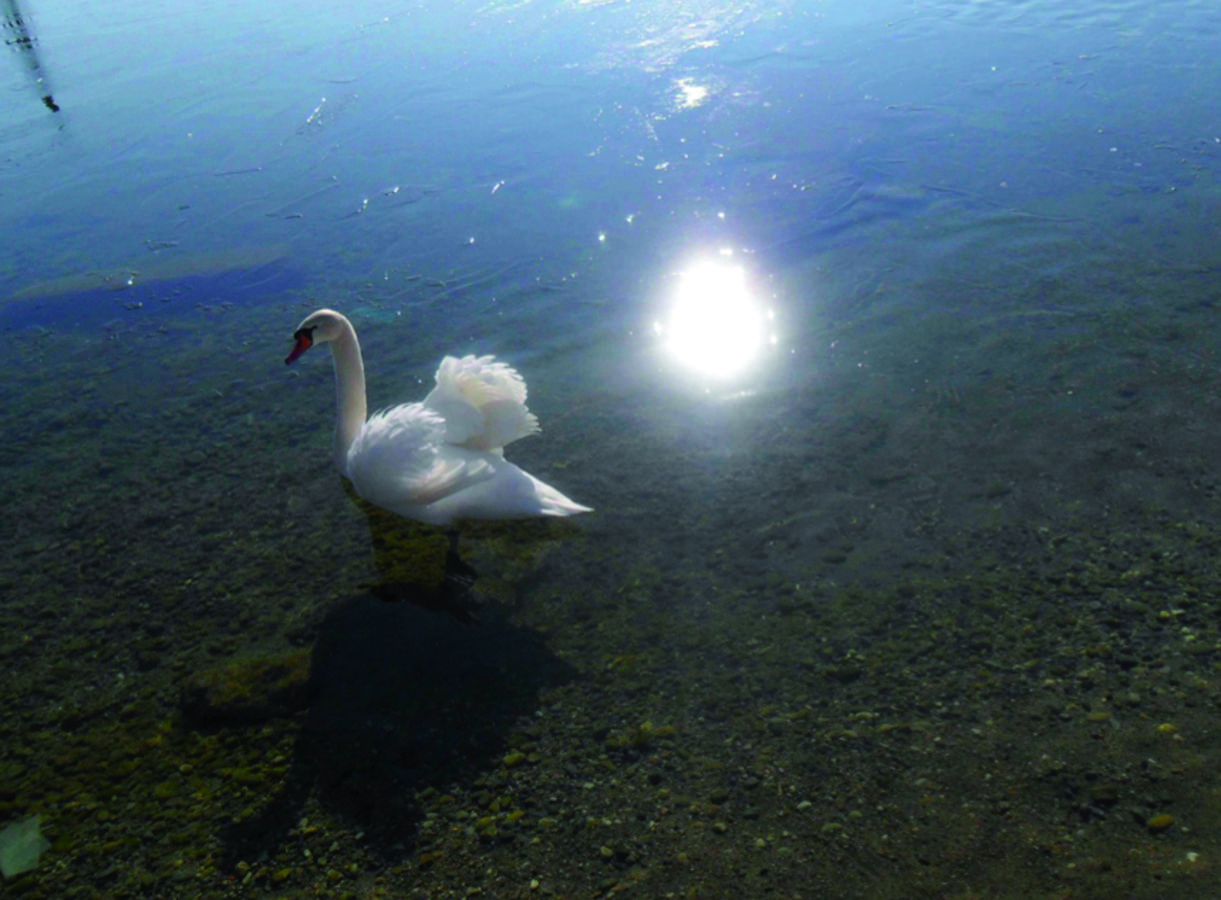
Fig. 18.9: ...and the swans of Lake Starnberg. More than 30 young people have successfully finished university education—their parents still lived an isolated neolithic life. A dramatic change.
References
Cerquiglini, Bernard (1993). La naissance du français. 2nd ed. Paris: Presses Universitaires de France.
Damerow, Peter (2012). The Origins of Writing and Arithmetic. In: The Globalization of Knowledge in History. Ed. by Jürgen Renn. Edition Open Access, 153–173. url: http://edition-open-access.de/studies/1/10/index.html.
Hariono, Bondan (2003). Tamu dari langit. Jakarta: Infojec.
Heeschen, Volker (1990). Ninye bún: Mythen, Erzählungen, Lieder und Märchen der Eipo im zentralen Bergland von Irian Jaya (West-Neuguinea), Indonesien. Berlin: Reimer.
Heeschen, Volker and Wulf Schiefenhövel (1983). Wörterbuch der Eipo-Sprache: Eipo-Deutsch-Englisch. Berlin: Reimer.
Hiepko, Paul and Wulf Schiefenhövel (1987). Mensch und Pflanze: Ergebnisse ethotaxonomischer und ethnobotanischer Untersuchungen bei den Eipo, zentrales Bergland von Irian Jaya (West-Neuguinea), Indonesien. Berlin: Reimer.
Kiki, Albert M. (1968). Ten Thousand Years in a Lifetime. Melbourne: Cheshire Publishers.
Koch, Gerd (1977). Die Eipo: Anatomie einer Steinzeitkultur. Bild der Wissenschaft 9:44–59.
Komando Daerah Militer XVII “Cenderawasih” (n.d.). Laporan expedisi ilmiah lembah-X, 2 Okt. sampai dengan 20 Des. 1969 di Irian Barat. [Report on the Scientific Expedition into the Valley of the X-River from 2 October 20 December 1969 in West-Irian]. Mimeograph.
Lawrence, Peter (1964). Road Belong Cargo: A Study of the Cargo Movements in the Southern Madang District New Guinea. Manchester: Manchester University Press.
Lorenz, Konrad (1973). Die Rückseite des Spiegels: Versuch einer Naturgeschichte menschlichen Erkennens. München: Piper.
McGrew, William C., Lindy F. Marchant, and Wulf Schiefenhövel, eds. (2013). The Evolution of Human Handedness. Annals of the New York Academy of Sciences 1288. Wiley-Blackwell.
Roegiest, Eugeen (2006). Vers les sources des langues romanes: Un itinéraire linguistique à travers la Romania. Leuven: Acco.
Schiefenhövel, Wulf (1976). Die Eipo-Leute des Berglands von Indonesisch-Neuguinea: Kurzer Überblick über den Lebensraum und seine Menschen. Einführung zu den Eipo-Filmen des Humanethnologischen Filmarchivs der Max-Planck-Gesellschaft. Homo 26(4):263–275.
– (1991). Eipo. In: Oceania. Ed. by Terence E. Hays. Encyclopedia of World Cultures 2. Boston: G.K. Hall & Co., 55–59.
– (2014a). Human Ethological Perspectives on Prehistoric Adaptation and Dispersal in the Central Highlands of New Guinea. In: Human Origin Sites and the World Heritage Convention in Asia. Ed. by Nuria Sanz. World Heritage Papers 39. Paris, Ciudad de Mexico: UNESCO, 235–254.
– (2014b). The Quest for Beauty and Powerful Expression: Examples from New Guinean Poetry. In: Art as Behaviour: An Ethological Approach to Visual and Verbal Art, Music and Architecture. Ed. by Gerhard Apfelbauer, Johanna Forster, Christian Lehmann, Wulf Schiefenhövel, and Christa Sütterlin. Hanse Studies 10. Oldenburg: Bis-Verlag, 407–435.
Vollmer, Gerhard (1975). Evolutionäre Erkenntnistheorie: Angeborene Erkenntnisstrukturen im Kontext von Biologie, Psychologie, Linguistik, Philosophie und Wissenschaftstheorie. Stuttgart: Hirzel.
